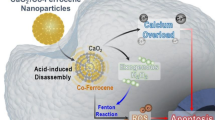Abstract
Malignant tumors are complex organs consisting of tumor cells and their microenvironment. Increasing evidence has shown that the tumor microenvironment is critical to the initiation and progression of tumors. Rational design of tumor therapies via targeting the tumor microenvironment to inhibit tumor growth is thus becoming a consensus strategy. Gd@C82(OH)22 nanoparticles, as novel endohedral hydroxylated metallofullerenes, have been demonstrated to be a potent antitumor nanomedicine via targeting multiple factors in the tumor microenvironment. Gd@C82(OH)22 nanoparticles possess excellent biocompatibility and remarkable antineoplastic activity, as a result not of direct tumor cytotoxicity but of their diverse biological effects, including antioxidation, immune activation, angiogenesis inhibition, imprisoning cancer cells, and reversal of drug-resistance. In this article, we summarize the unique nanoscale physiochemical properties and the antineoplastic activities of Gd@C82(OH)22 nanoparticles, and focus on the mechanisms underlying their regulation of the tumor microenvironment.
Article PDF
Similar content being viewed by others
Avoid common mistakes on your manuscript.
References
Bissell M J, Radisky D. Putting tumours in context. Nat Rev Cancer, 2001, 1: 46
Bissell M J, Hines W C. Why don’t we get more cancer? A proposed role of the microenvironment in restraining cancer progression. Nat Med, 2011, 17: 320–329
Avastin (bevacizumab) Information. U.S. Food and Drug Adminis-tration. http://www.fda.gov/Drugs/DrugSafety/Postmarket-DrugSafety-InformationforPatientsandProviders/ucm193900.htm
Yan L, Zhao F, Li S F, et al. Low-toxic and safe nanomaterials by surface-chemical design, carbon nanotubes, fullerenes, metallofullerenes, and graphenes. Nanoscale, 2011, 3: 362–382
Qu L, Cao W B, Xing G M, et al. Study of rare earth encapsulated carbon nanomolecules for biomedical uses. J Alloy Compd, 2006, 408/412: 400–404
Xing G M, Yuan H, He R, et al. The strong MRI relaxivity of paramagnetic nanoparticles. J Phys Chem B, 2008, 112: 6288–6291
Chen C Y, Fang X H. Multi hydroxylated [Gd@C82(OH)22]n nanoparticles: antineoplastic activity of high efficiency and low toxicity. Nano Lett, 2005, 5: 2050–2057
Yin J J, Lao F, Fu P P, et al. The scavenging of reactive oxygen species and the potential for cell protection by functionalized fullerene materials. Biomaterials, 2009, 30: 611–621
Meng H, Xing G M, Sun B Y, et al. Potent angiogenesis inhibition by the particulate form of fullerene derivatives. ACS Nano, 2010, 4: 2773–2783
Wang J X, Chen C, Li B, et al. Antioxidative function and biodistribution of [Gd@C82(OH)22]n nanoparticles in tumor-bearing mice. Biochem Pharmacol, 2006, 71: 872–881
Liu Y, Jiao F, Qiu Y, et al. The effect of Gd@C82(OH)22 nanoparticles on the release of Th1/Th2 cytokines and induction of TNF-alpha mediated cellular immunity. Biomaterials, 2009, 30: 3934–3945
Yang D, Zhao Y L, Guo H, et al. [Gd@C82(OH)22]n nanoparticles induce dendritic cell maturation and activate Th1 immune responses. ACS Nano, 2010, 4: 1178–1186
Meng H, Xing G, Blanco E, et al. Gadolinium metallofullerenol nanoparticles inhibit cancer metastasis through matrix metalloproteinase inhibition: imprisoning instead of poisoning cancer cells. Nanomedicine: NBM, 2012, 8: 136–146
Tang J, Xing G, Yuan H, et al. Tuning electronic properties of metallic atom in bondage to a nanospace. J Phys Chem B, 2005, 109: 8779–8785
Tang J, Xing G, Zhao Y, et al. Periodical variation of electronic properties in polyhydroxylated metallofullerene materials. Adv Mater, 2006, 18: 1458–1462
Cheng Y, Liu K M, Xing G, et al. Study of multihydroxylated processes of Gd@C82 by ICP-MASS. J Radioanal Nucl Chem, 2007, 272: 537–540
Tang J, Xing G M, Zhao F, et al. Modulation of structural and electronic properties of fullerene and metallofullerenes by surface chemical modifications. J Nanosci Nanotechnol, 2007, 7: 1085–1101
Yue D M, Bai X J, Zhao S X, et al. First endohedral metallo-fullerene-containing polymer: preparation and characterization of Gd@C82-Polystyrene. J Phys Chem C, 2010, 114: 7631–7636
Tang J, Xing G, Yuan H, et al. 5p Electronic properties of Gd in Gd@C82(OH)x studied by synchrotron radiation XPS. J Radioanal Nucl Chem, 2007, 272: 307–310
Tang J, Xing G, Zhao Y, et al. Switchable semiconductive property of the polyhydroxylated metallofullerene. J Phys Chem B, 2007, 111: 11929–11934
Zhao S X, Zhang J, Dong J Q, et al. Scanning tunneling microscopy investigation of substrate-dependent adsorption and assembly of metallofullerene Gd@C82 on Cu(111) and Cu(100). J Phys Chem C, 2011, 115: 6265–6268
Zhang W D, Sun B, Zhang L, et al. Biosafety assessment of Gd@C82(OH)22 nanoparticles on Caenorhabditis elegans. Nanoscale, 2011, 3: 2636–2641
Yin J J, Lao F, Meng J, et al. Inhibition of tumor growth by endohedral metallofullerenol nanoparticles optimized as reactive oxygen species scavenger. Mol Pharmacol, 2008, 74: 1132–1140
Liang X J, Meng H, Wang Y, et al. Metallofullerene nanoparticles circumvent tumor resistance to cisplatin by reactivating endocytosis. Proc Natl Acad Sci USA, 2010, 107: 7449–7454
Author information
Authors and Affiliations
Corresponding author
Additional information
This article is published with open access at Springerlink.com
Rights and permissions
Open Access This article is distributed under the terms of the Creative Commons Attribution 2.0 International License (https://creativecommons.org/licenses/by/2.0), which permits unrestricted use, distribution, and reproduction in any medium, provided the original work is properly cited.
About this article
Cite this article
Li, Y., Tian, Y. & Nie, G. Antineoplastic activities of Gd@C82(OH)22 nanoparticles: tumor microenvironment regulation. Sci. China Life Sci. 55, 884–890 (2012). https://doi.org/10.1007/s11427-012-4387-7
Received:
Accepted:
Published:
Issue Date:
DOI: https://doi.org/10.1007/s11427-012-4387-7




